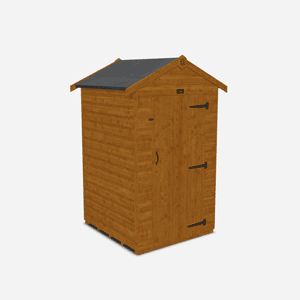What Is the Right Garden Building for Me?
Published: 04/06/2021

A garden building can serve a variety of purposes, depending on your needs, preferences, and available garden space. The versatility of garden buildings allows you to adapt them to various purposes, making them a valuable and flexible addition to your property.
First, here are some factors to consider when making your decision:
What Will it Be Used For?
Storage: If you need extra storage for tools, equipment, or seasonal items, a garden shed might be suitable.
Workspace: If you plan to use the building as a workspace for hobbies or DIY projects, a larger shed, workshop, or studio may be necessary.
Relaxation: For a space to unwind, a garden room, cabin, or gazebo might be more appropriate.
Gardening: A dedicated space for gardening activities such as potting and growing plants.
Here's some additional info about different ways you can use a garden building.
Storage Shed:
Ideal for storing gardening tools, equipment, lawn mowers, bicycles, and other outdoor items. It helps keep your garden organised and free from clutter.
Workshop:
A garden building can be transformed into a workshop for DIY projects, woodworking, crafting, or any other hands-on hobbies. Make sure it has adequate lighting, power outlets, and ventilation.

A Tiger Potting Shed converted into a light filled creative space.
Home Office:
With the rise of remote work, garden buildings can be converted into comfortable home offices. This provides a quiet and separate space away from the distractions of the main house. Here’s a great guide on How to Build your Perfect Garden Office.
Studio or Creative Space:
Artists, writers, musicians, or anyone in need of a creative space can use a garden building as a dedicated studio. The natural light and quiet surroundings can enhance creativity.
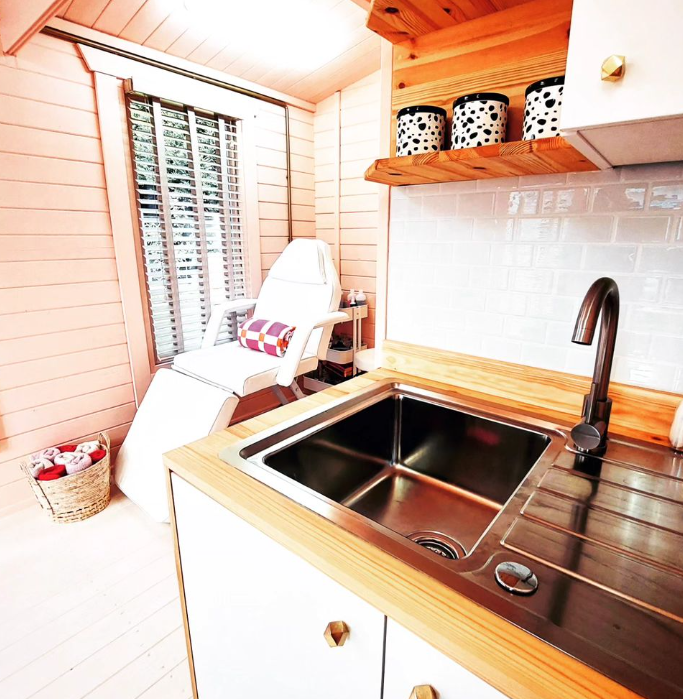
A Tiger Log Cabin converted into a beauty salon
Garden Room or Summerhouse:
Create a tranquil space for relaxation and leisure. A garden room or summerhouse can be a retreat for reading, meditation, or simply enjoying the beauty of your garden.
Greenhouse:
If you're passionate about gardening or want to grow your own plants, a greenhouse provides a controlled environment for cultivating flowers, herbs, vegetables, or exotic plants.
Guest Room:
Some larger garden buildings can be converted into guest accommodation. This is especially useful if you have frequent visitors or need extra space for guests.
Fitness or Yoga Studio:
Utilise the space for exercise and wellness activities. A garden building can be transformed into a home gym, yoga studio, or a space for other fitness routines. Here’s a useful guide on How to Turn a Shed into a Home Gym.
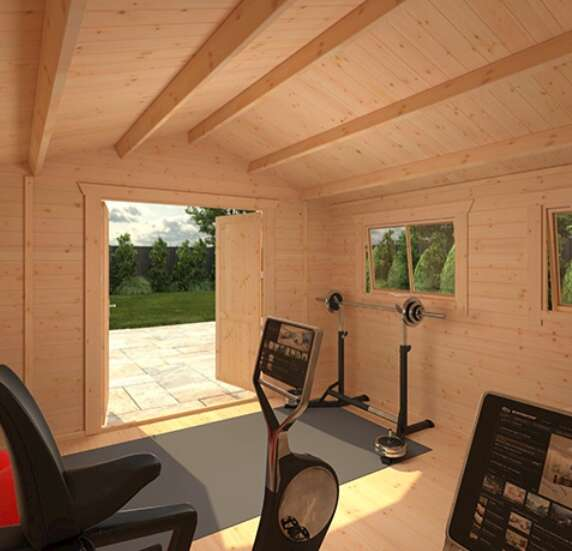
Tiger Sheds Javan Log Cabin converted into a home gym.
Entertainment Room:
Set up a space for watching movies, playing games, or hosting gatherings with friends and family. Equip it with comfortable seating, entertainment systems, and perhaps a small bar.

A Tiger Log Cabin converted into a beautiful entertaining space.
Children's Playhouse:
Create a magical play space for children, complete with toys, games, and a cosy spot for imaginative play. It's a great way to encourage outdoor activities.

A Tiger Log Cabin converted into a child’s play space.
Hobby Room:
Dedicate the space to a specific hobby, such as model trains, painting, or photography. Customise the interior to suit the needs of your passion.

A Tiger Log Cabin that has been converted into an art studio.
Potting Shed:
Specifically designed for gardening enthusiasts, a potting shed provides a space for repotting plants, seed starting, and other gardening tasks.
How Much Space is There?
The available space for a garden room in your yard depends on the size of your garden, local regulations, and your specific needs. Assess the dimensions of your outdoor space, considering existing features and pathways. Check local zoning laws to understand any restrictions on the size and placement of structures. The purpose of the garden room will also influence the required space; whether it's a small reading nook or a fully functional home office. Ensure the scale and proportion harmonise with your garden and home, and plan for easy access and optimal views.
Have you got a tight corner in your garden that’s currently a waste of space? If space is at a premium in your garden but you really want to access all the benefits of owning a small corner garden building, a corner garden shed, corner summerhouse or corner log cabin can help you maximise your garden storage and lifestyle.

Tiger Sheds Vibrissa Log Cabin - 44mm
The corners of our gardens are often undervalued and underused. Given that this space might not receive a huge amount of sunshine, how about devoting a corner of your garden to a corner garden building? Trust us, you’ll hardly notice that you've lost any garden space.
Check local regulations or homeowner association guidelines for any restrictions on building size or placement.
By carefully evaluating these factors, you can determine how much space is available and how to make the most of your garden room.
What Material Should I Use?
Wood: Wooden structures can provide a natural and aesthetically pleasing look and is a popular choice for durability and resistance to decay.
Metal: Metal buildings are durable and require less maintenance, but they may not blend as seamlessly into a garden setting.
Vinyl/Plastic: Low-maintenance and durable but may lack the aesthetic appeal of wood.
Timber stands out as the optimal material for garden buildings due to its unique combination of aesthetic appeal, environmental sustainability, and practical benefits. Its natural warmth and timeless beauty seamlessly integrate with outdoor surroundings, providing an inviting and charming atmosphere. With responsible sourcing, timber emerges as an eco-friendly choice, aligning with sustainable practices. Beyond its visual and environmental merits, timber boasts versatility in design, ease of construction and insulating properties, ensuring comfort throughout the seasons. Renowned for durability and repairability, timber structures can withstand the elements and adapt to changing needs, making them a durable, flexible, and enduring choice for creating delightful and functional garden spaces.
It's essential to choose the best quality timber for your garden building. The type of timber you use affects its appearance, strength, and durability. Here at Tiger, we prioritise using top-quality timber, and we believe you should too when making a purchase. While the appearance, size, and price of your garden building are important, the quality of the timber is crucial. It determines how easy it is to use and maintain, as well as how long it will last. Investing in high-quality timber is a smart choice.
Why settle for a cheap garden building that may look good in pictures but comes with numerous defects? It could be filled with knotholes, have splits, be difficult to assemble, and experience warping and water issues within a short period of time.
At Tiger we source top-grade European Softwood timber, primarily Scandinavian Timber, in superior grades. All the timber we use is 'kiln dried', ensuring consistent moisture levels and preventing warping or deformities.
The thickness of the timber used in your garden building is a great place to start, as the thicker the wall, the more energy efficient it will be.
Log cabins are made of interlocking logs which join to create a solid structure with no visible gaps. A tight fit between logs results in a building that is more resistant to damp and wind penetration, extending the life of the cabin. If you plan to use your building all year-round, it’s a good idea to choose a log cabin with thicker logs – especially if you live in a colder climate like the UK. Log cabins are available in a variety of thicknesses; we have buildings manufactured from 19mm, 28mm and 44mm logs. We’d recommend 44mm thick logs for an effective, natural level of insulation.
There are stark differences between the quality of wooden sheds – they are not all made equal! Cheaper sheds can use OSB (orientated strand board) on the floor and roof, to keep the price down, but the cons of OSB is that the sheets swell up when exposed to water and damp condition and offers little protection. Look for a shed that has strong 12mm shiplap cladding and tongue and groove floorboards and roof boards to prevent the wind and rain getting inside, making them extra strong and long lasting.
A Tiger Shed benefits from…
- Strong 12mm shiplap cladding with scalloping to have prevent water ingress
- Superior tongue & groove timber board
- No cheap OSB board is used
- Slow grown European softwood, cut in our Yorkshire woodmill to a high grade
- Pre-treated with TigerSkin®, a specially formulated wood preserver developed over many years – for a non-greasy weatherproof seal before it leaves the workshop
Dip-treated Timber vs Pressure-treated Shiplap Timber

The type of treatment is also important to consider. Most sheds are dip treated. This means the wood is submerged in a protective preservative and left to dry – protecting the shed in the short term. Tiger treat these sheds with TigerSkin® (our own dip treatment) to improve water resistance and preserve the shed’s appearance. To protect these sheds in the long-term, it would be wise to treat it with TigerSkin at least once a year.
Pressure treatment involves submerging the wood at high-pressure to penetrate the wood. Tiger’s pressure-treated sheds are submerged in Tanalith E – the latest form of pressure treatment for timber. A tanalised shed offers several noteworthy benefits and provides enhanced protection against decay, insects, and fungal growth. As a result, tanalised sheds can cost more, but exhibit increased durability, requiring less maintenance and offering an extended lifespan compared to untreated counterparts. The preservation process also provides resistance to weathering, ensuring the shed withstands the elements more effectively. This makes tanalised sheds an excellent choice for outdoor structures, offering a balance of aesthetic appeal and long-term reliability, while requiring minimal upkeep over the years.
What Should my Budget Be?
Determine your budget early in the process. Different materials and designs can significantly impact the cost of a garden building.
Garden buildings come in a wide range of prices, depending on factors like size, materials, design complexity, and extra features. Smaller, simpler structures like basic sheds are usually more budget-friendly and great for storage. On the other hand, larger buildings with added features like insulation, electricity, or fancy designs can drive up the cost. The type of material used also affects the price; timber might be pricier than metal or plastic, even though it's more visually appealing and eco-friendly.
Customisation and professional installation can add to the expenses. Prefabricated or self-assembled options might be cheaper than custom-built ones. It's important to think about your budget, how you plan to use the building, and your personal preferences before deciding, so you can find a garden building that meets your needs without breaking the bank.
- A garden shed can cost anywhere from £300 for a value shed to £4,000 for a high calibre log cabin shed.
- A standard log cabin can cost in the region of £800 and up to £11,000 for a 44mm premium log cabin.
Here are a few more things to think about when deciding on the perfect garden structure for you:
Design and Style
Consider the architectural style of your home and choose a garden building that complements it.
Think about windows, doors, and roofing styles that match your preferences and the overall design of your garden.
The two most common types of shed roofs are the apex and pent. The apex roof has two equal slopes that form two triangular sections (gables) in the middle (one at each end). By contrast, the pent roof has a flat surface and only one slope. Here are a couple of factors to consider when choosing between an apex or pent roof:
Apex sheds tend to offer more headroom than the pent alternative. So if you’re tall, or you’re looking for extra storage space up top, or you want to build a garden gym, an apex could be the answer. If you must have a pent roof for its looks and status as a space saver, but still want more headroom, the Tiger Shiplap Extra High Pent may be what you need. However, that may come at extra cost when compared to the standard pent or apex shed. In terms of appearance, apex sheds are more traditional, while sheds with pent roofs look more modern.
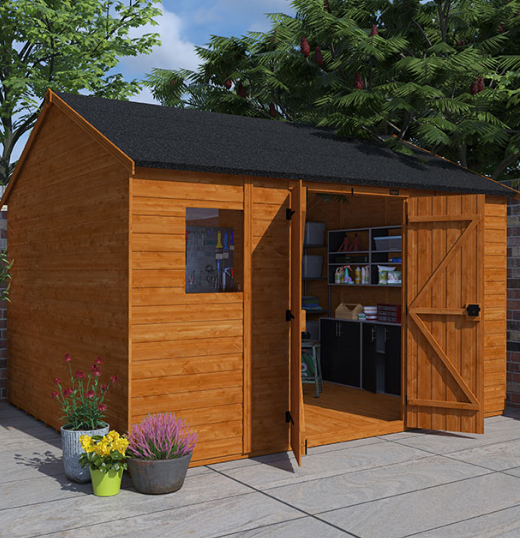
An example of an apex shed roof
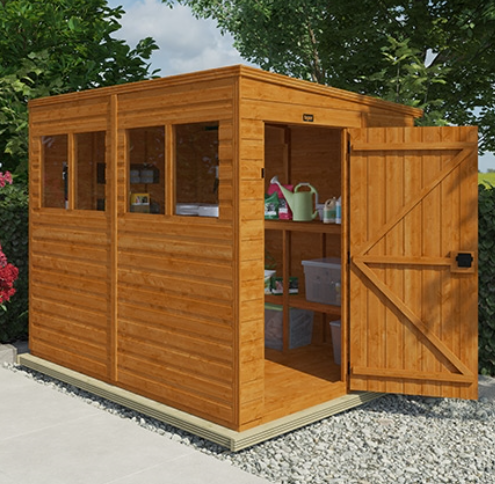
An example of a pent shed roof
Types of Garden Buildings
There are so many different types of garden buildings, each with their own purpose and unique way of enhancing outdoor spaces.
Garden Sheds
A garden shed is a versatile addition to any outdoor space, offering a range of benefits and practical uses. Primarily, it serves as a dedicated storage solution, providing shelter for gardening tools, equipment, and seasonal items, helping maintain a clutter-free garden. Beyond storage, sheds can be transformed into functional workspaces, serving as workshops for DIY projects or hobby areas. Their compact design allows for efficient organisation, making it easy to access and manage tools. Moreover, sheds contribute to the overall aesthetic of the garden, with various styles and materials available to complement different landscapes. Whether utilised for gardening needs, a creative workspace, or merely extra storage, a well-designed garden shed enhances both the functionality and visual appeal of outdoor spaces.
Wood is the traditional material for a garden shed, and by far the most popular. Many sizes and styles of timber shed are available, and they can easily be painted to your chosen colour. Wood’s natural beauty and relative durability makes it a great choice for garden buildings.

https://www.tigersheds.com/product/tiger-overlap-apex-shed/

Tiger Sheds Overlap Double Toolshed
Find out more in our Shed Buying Guide.
Log Cabins
A log cabin presents a charming and multifaceted addition to outdoor spaces, offering a range of benefits and versatile uses. With its rustic and natural aesthetic, a log cabin creates a cosy retreat, blending seamlessly with the surrounding environment. These structures are well-suited for use as home offices, providing a tranquil and inspiring workspace amidst nature. Additionally, log cabins serve as comfortable guest accommodations, offering a private and inviting space for visitors. Their insulated design makes them suitable for year-round use, providing warmth in winter and a cool respite in summer. Used as a personal sanctuary, a functional workspace, or extra living space, a log cabin adds character to the garden while delivering a harmonious blend of comfort and natural beauty.
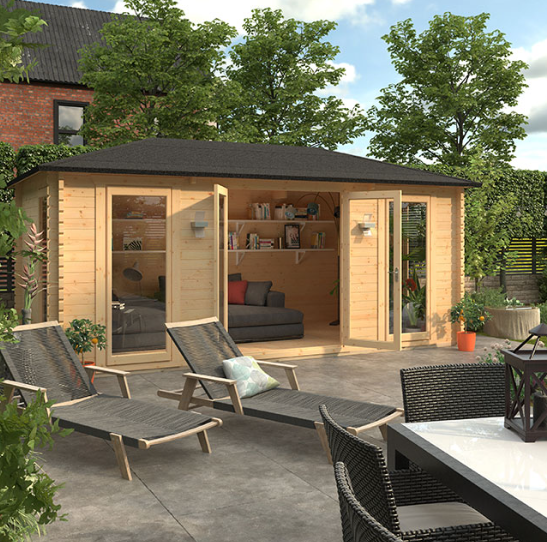
https://www.tigersheds.com/product/the-sampi-44mm-log-cabin/
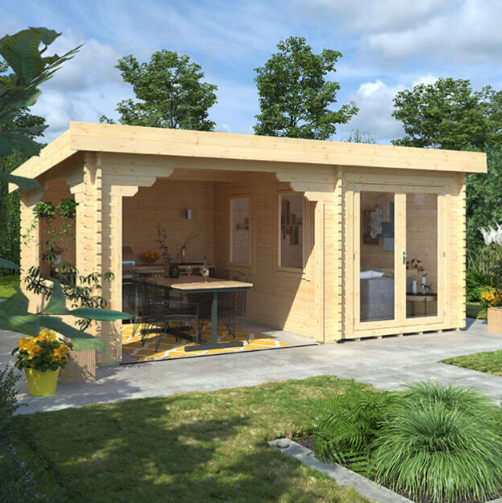
Tiger Sheds – The Hotham 44mm Log Cabin
Read our Log Cabin Buying Guide for more information.
Summerhouses
A summerhouse is a wonderful addition to any garden, offering a wide range of benefits. It is primarily designed for relaxation, providing a peaceful getaway amid nature. The open and airy design, often featuring large windows, allows plenty of natural light to flood in, creating a cosy spot for reading, meditation, or simply unwinding. Summerhouses are also perfect for hosting social gatherings, afternoon tea parties, or engaging in family activities. Moreover, these structures make outdoor spaces more usable, allowing people to enjoy their gardens even when the weather is less than ideal. Available in various styles and sizes, a summerhouse not only enhances the beauty of the garden but also adds functionality, making it a charming retreat for a variety of leisurely pursuits.
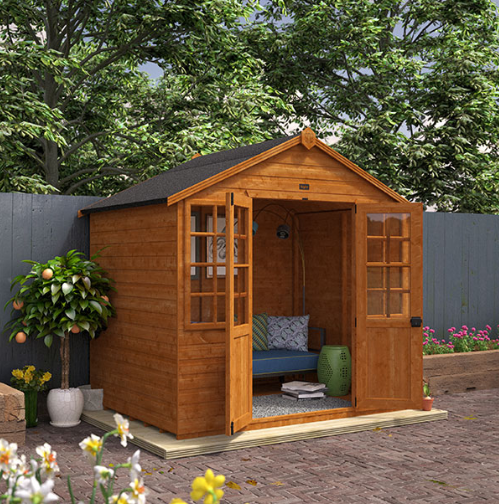
https://www.tigersheds.com/product/tiger-summerhouse/
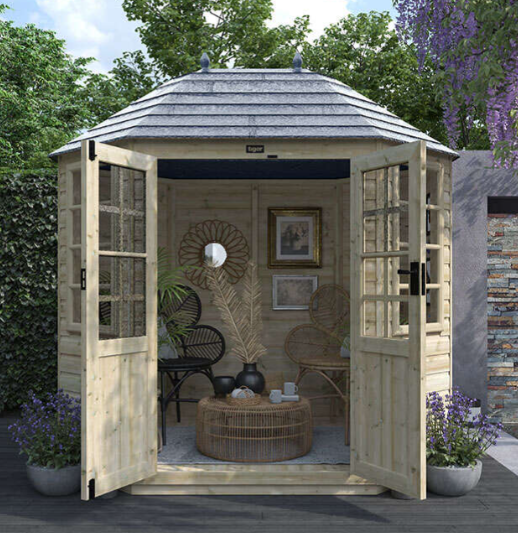
Tiger Sheds Elite Pressure Treated Octagonal Summerhouse
Find out why a summerhouse could be right for you in our Summerhouse Buying Guide.
Wooden Playhouses
A wooden playhouse can bring a touch of magic to any backyard, providing a special place for kids to play and use their imagination. These cute little houses are built to last, ensuring a safe and sturdy environment for children to enjoy. With their natural look, they fit right in with the outdoor surroundings, adding a bit of charm to the backyard. Not only are they great for playtime, but they also encourage kids to stay active and have fun outdoors. Overall, a wooden playhouse is a fantastic addition that enhances the outdoor space for the whole family to enjoy.
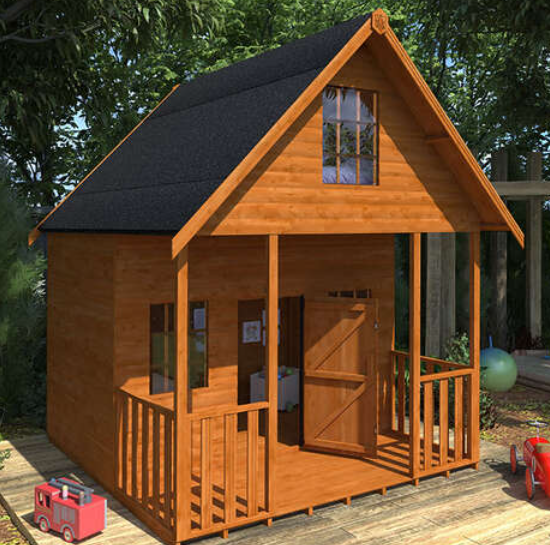
https://www.tigersheds.com/product/tigercub-loglap-lounge-playhouse/

Tiger Sheds – Tigercub Crazy Cottage Playhouse
Other Types of Garden Buildings
Apart from the usual garden structures like sheds and playhouses, there are many other garden buildings that offer unique features and improve outdoor living spaces.
For example, timber garages not only provide secure storage for vehicles but can also be used as workshops or extra storage areas.
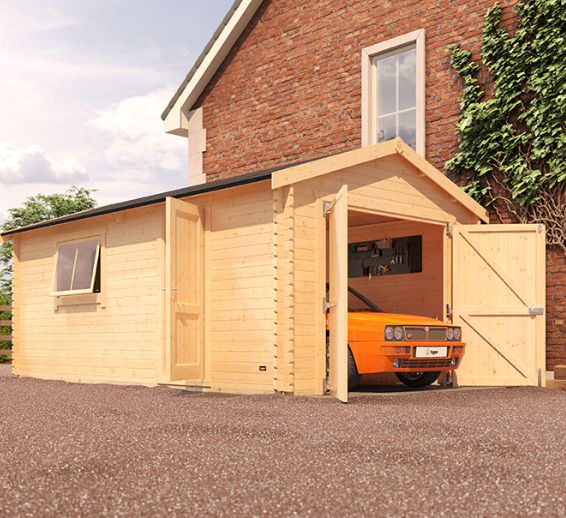
https://www.tigersheds.com/product/the-malayan-garage-44mm-log-cabin/
Wooden greenhouses and potting sheds create controlled environments for year-round gardening, allowing plants to be cultivated in different seasons.

https://www.tigersheds.com/product/tiger-potting-shed/
Gazebos and garden shelters are charming outdoor shelters that offer a shaded space for relaxation or socialising.
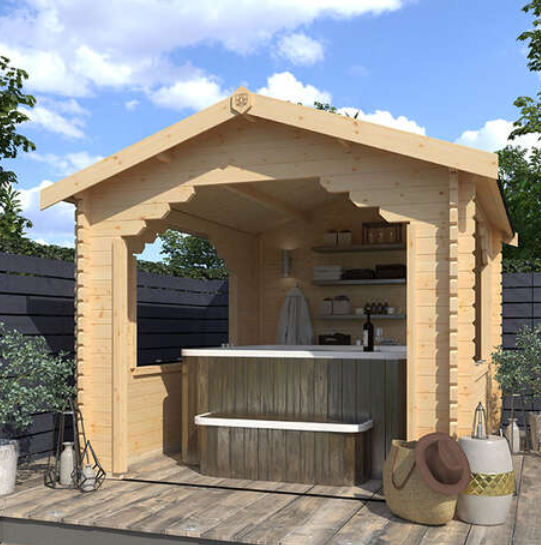
https://www.tigersheds.com/product/the-sumatran-shelter-44mm-log-cabin-for-bbqs-hot-tubs-or-cars/
Each garden building serves specific needs, whether it's for storage, gardening, entertainment, or simply enhancing the overall look of the outdoor environment. The flexibility in design and purpose allows individuals to personalise their gardens with structures that suit their preferences and lifestyle.
Extras to Consider
Insulation
Insulation not only keeps you warm but also offers a range of other advantages:
1. Soundproofing: Good insulation in your garden room not only keeps it cosy but also helps reduce unwanted noise. This is especially important if you use your cabin as a home office or studio, as it can help you stay focused and productive.
2. Improved Security: Thicker walls in your garden building not only provide better insulation but also enhance security. A strong structure is more resistant to vandalism or break-ins. Additionally, well-sealed doors and windows offer extra protection.
3. Energy Efficiency: Insulation is essential if you plan to spend a lot of time in your home office. It enhances energy efficiency, leading to lower energy bills. Whether you use it as a home office, gym, or entertainment area, effective insulation can help you cut down on energy expenses.
4. Added Value: Insulating your space opens a world of possibilities and increases the value of your property. It can turn your cabin into a professional setting like a beauty salon or recording studio. With proper insulation, you can enjoy your retreat throughout the year, no matter the weather.
Electricity
When setting up electricity for your garden room, it's essential to connect the consumer unit to the electric mains in your home. To do this, you'll need the assistance of a qualified electrician to install an underground armoured cable that runs from your house to the garden building. To make things easier and more cost-effective, consider placing your garden home office in a location that allows for a clear path for the cable. This will help reduce installation costs and prevent future complications.
Before you proceed with running electricity to your garden shed, it's crucial to follow the rules and regulations set by local authorities. Contact your local building department to ensure that you meet all the necessary legal requirements. These regulations are in place to ensure safety and prevent hazards such as electric shocks and fires. Some common requirements include obtaining permits, adhering to safety standards, and hiring a licensed electrician for the installation. Additionally, make sure to use outdoor-rated electrical components, Ground Fault Circuit Interrupter (GFCI) protection, and weatherproof enclosures as needed. By staying informed about these legal requirements, you can ensure a safe and compliant electrical setup for your garden shed.
Wood Protector / Preserver
Taking care of a timber garden room is crucial if you want it to last and look good. To keep it in top shape, make sure to regularly treat the wood with preservatives, stains, or sealants. This will protect it from decay, bugs, and the elements. Start by giving the timber a thorough cleaning to get rid of any dirt or debris. Then, apply a suitable wood preservative or sealant to create a barrier that shields the wood. Not only will this enhance its natural beauty, but it will also protect it from the damaging effects of the sun and moisture. By preserving your timber garden room, you'll ensure that it remains strong, visually appealing, and able to withstand outdoor conditions. Plus, regular maintenance can save you money in the long run by preventing costly repairs or premature replacements.
Security
To enhance the security of your garden building, there are various steps you can take.
- Firstly, ensure that you have sturdy locks on both the doors and windows to deter unauthorised access. Consider installing motion-activated lighting around the office perimeter for added security and visibility at night. Investing in a security system with cameras and alarms that can be connected to your home network for remote monitoring is also recommended.
- Planting thorny plants near windows can act as a natural deterrent.
- Make sure your garden building is easily visible from your home to discourage potential intruders.
- Store valuable equipment in secure cabinets or lockers within the office.
You can also consider a security shed with special features like narrow 'slit' windows and a free security bar for added protection.
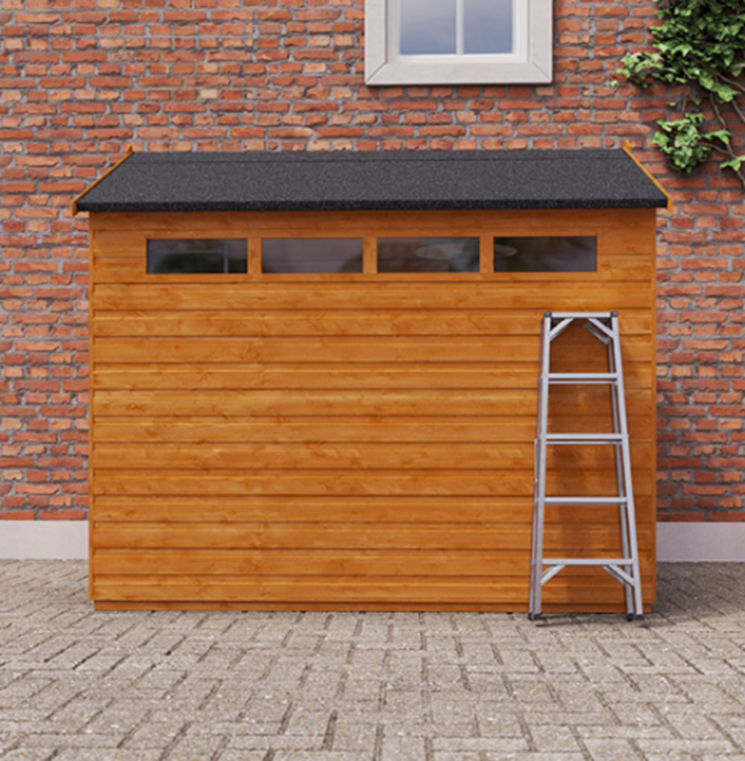
Tiger Sheds – Security Shed
Assembly and Installation
Consider whether you want a DIY garden building that you can assemble yourself or if you prefer professional installation. Some structures may require a solid foundation.
Future Use
Consider your future needs. If you think your requirements may change, choose a versatile building that can adapt to different uses.
By carefully considering these factors, you can make an informed decision that meets your specific needs and enhances the overall appeal of your garden.
Find your perfect space with Tiger Sheds. Choose from hundreds of innovative garden building designs or use our bespoke design service. We offer the Tiger 20 Year Guarantee for your peace of mind.


